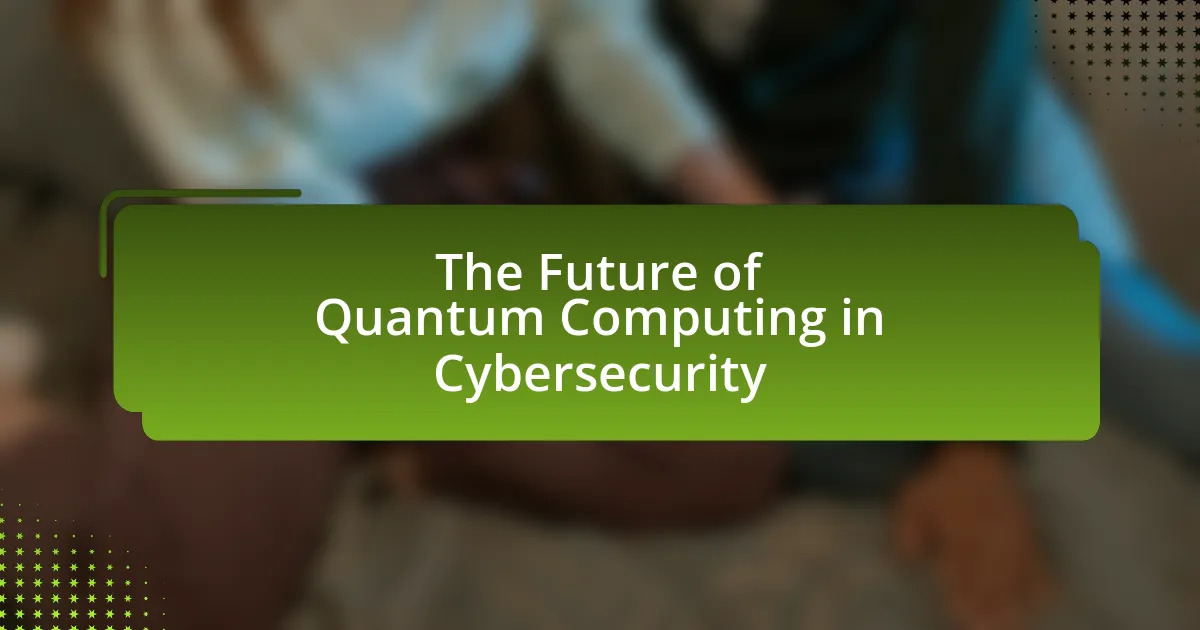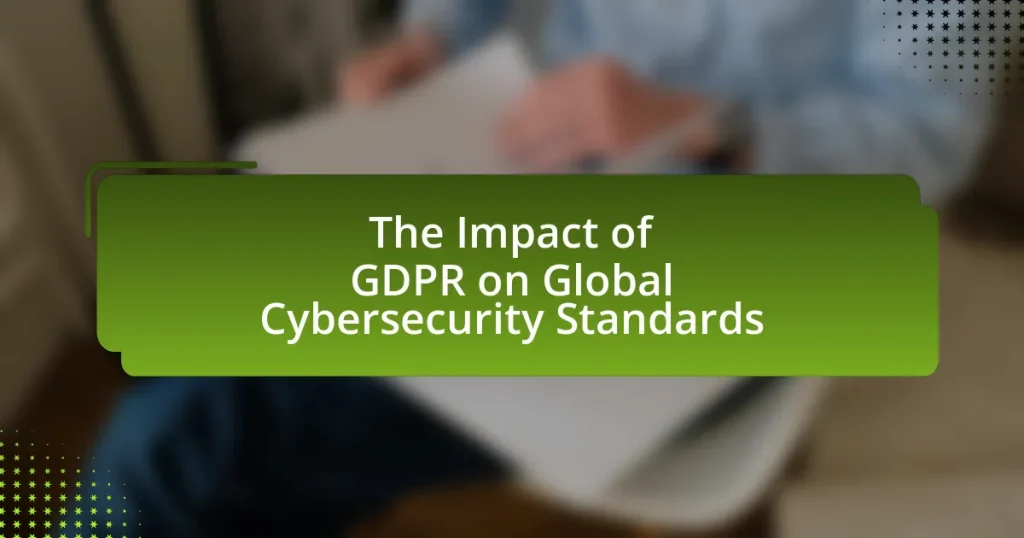The article focuses on the future of quantum computing in cybersecurity, highlighting its potential to transform data protection through advanced encryption and threat detection methods. It discusses the vulnerabilities of traditional encryption algorithms, such as RSA and ECC, to quantum attacks and emphasizes the need for quantum-resistant algorithms, as advocated by the National Institute of Standards and Technology (NIST). Key principles of quantum computing, including superposition and entanglement, are explored in relation to their implications for data privacy and security. The article also outlines the advancements in quantum-resistant technologies, the role of governments and organizations in fostering quantum cybersecurity initiatives, and the necessary skill sets for cybersecurity professionals in a quantum-enabled landscape.
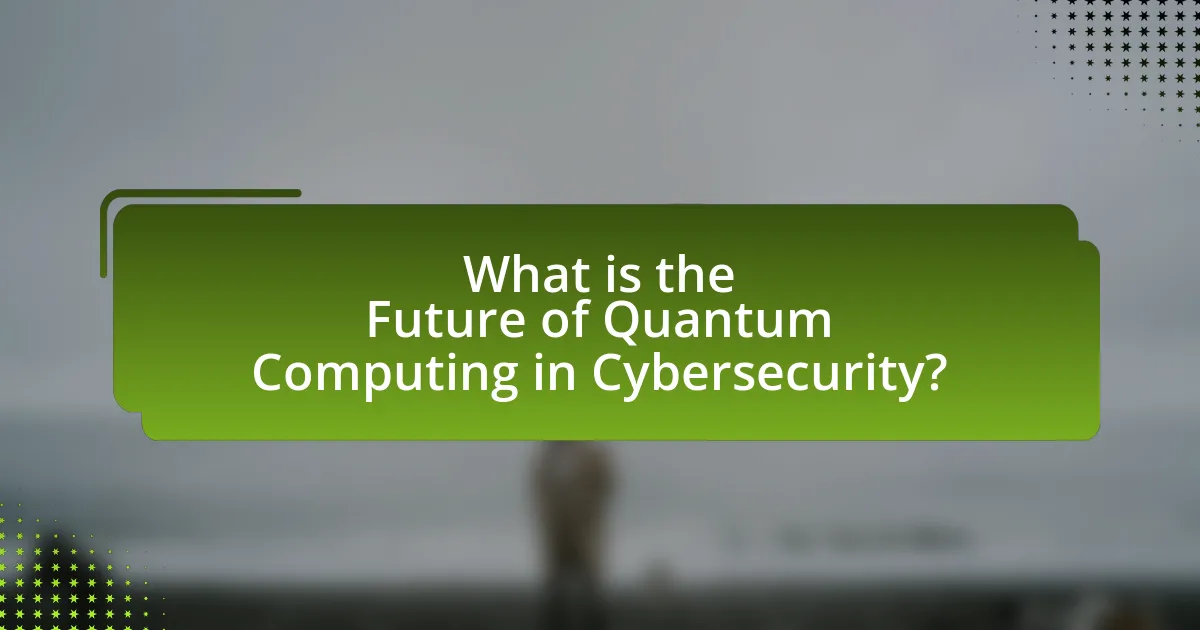
What is the Future of Quantum Computing in Cybersecurity?
The future of quantum computing in cybersecurity is poised to revolutionize data protection through advanced encryption methods and threat detection capabilities. Quantum computers can potentially break traditional encryption algorithms, such as RSA and ECC, which rely on the difficulty of factoring large numbers or solving discrete logarithms. This vulnerability necessitates the development of quantum-resistant algorithms, as highlighted by the National Institute of Standards and Technology (NIST), which is actively working on standardizing post-quantum cryptography to safeguard sensitive information against quantum attacks. Additionally, quantum key distribution (QKD) offers a method for secure communication by leveraging the principles of quantum mechanics, ensuring that any eavesdropping attempts can be detected. As quantum technology continues to advance, its integration into cybersecurity strategies will be critical for maintaining data integrity and confidentiality in an increasingly digital world.
How does quantum computing differ from classical computing in cybersecurity?
Quantum computing fundamentally differs from classical computing in cybersecurity by its ability to solve complex mathematical problems exponentially faster, which can undermine traditional encryption methods. Classical computing relies on algorithms that take a significant amount of time to break encryption keys, such as RSA, which is based on the difficulty of factoring large numbers. In contrast, quantum computers utilize quantum bits (qubits) and algorithms like Shor’s algorithm, which can factor these large numbers in polynomial time, potentially rendering current encryption methods obsolete. This capability poses a significant threat to data security, as it could allow unauthorized access to sensitive information that is currently protected by classical encryption techniques.
What are the fundamental principles of quantum computing relevant to cybersecurity?
The fundamental principles of quantum computing relevant to cybersecurity include superposition, entanglement, and quantum algorithms. Superposition allows quantum bits (qubits) to exist in multiple states simultaneously, enabling faster processing of complex problems compared to classical bits. Entanglement creates a strong correlation between qubits, which can be utilized for secure communication methods like quantum key distribution (QKD). Quantum algorithms, such as Shor’s algorithm, can efficiently factor large numbers, posing a threat to traditional encryption methods. These principles highlight the potential of quantum computing to both enhance cybersecurity through advanced encryption techniques and challenge existing security protocols.
How does quantum computing enhance data encryption methods?
Quantum computing enhances data encryption methods by utilizing quantum algorithms that can solve complex mathematical problems significantly faster than classical computers. For instance, Shor’s algorithm allows quantum computers to factor large integers exponentially quicker, which threatens traditional encryption methods like RSA. This capability prompts the development of quantum-resistant encryption algorithms, such as lattice-based cryptography, which are designed to withstand potential quantum attacks. The National Institute of Standards and Technology (NIST) is actively working on standardizing these post-quantum cryptographic algorithms to ensure data security in a future where quantum computing is prevalent.
What potential threats does quantum computing pose to current cybersecurity measures?
Quantum computing poses significant threats to current cybersecurity measures primarily by enabling the rapid decryption of widely used cryptographic algorithms. Classical encryption methods, such as RSA and ECC, rely on the difficulty of factoring large numbers or solving discrete logarithm problems, which quantum computers can efficiently solve using algorithms like Shor’s algorithm. This capability could render traditional encryption methods obsolete, exposing sensitive data and communications to unauthorized access. For instance, a sufficiently powerful quantum computer could break RSA encryption in a matter of hours, a task that would take classical computers thousands of years. As a result, the transition to quantum-resistant cryptographic algorithms is essential to safeguard data against these emerging threats.
How could quantum computers break traditional encryption algorithms?
Quantum computers could break traditional encryption algorithms by leveraging their ability to perform complex calculations at unprecedented speeds, particularly through algorithms like Shor’s algorithm. Shor’s algorithm can factor large integers exponentially faster than the best-known classical algorithms, which undermines the security of widely used encryption methods such as RSA and ECC that rely on the difficulty of factoring large numbers. For instance, while classical computers may take thousands of years to factor a 2048-bit RSA key, a sufficiently powerful quantum computer could accomplish this in mere hours or even minutes, rendering the encryption ineffective. This potential capability poses a significant threat to data security and privacy, as it could allow unauthorized access to sensitive information protected by these traditional encryption schemes.
What are the implications of quantum computing on data privacy?
Quantum computing poses significant implications for data privacy by potentially breaking traditional encryption methods. Classical encryption relies on mathematical problems that are computationally infeasible for classical computers to solve, such as factoring large integers. However, quantum computers can utilize algorithms like Shor’s algorithm, which can efficiently factor these integers, thereby compromising the security of widely used encryption standards such as RSA and ECC. This vulnerability raises concerns about the confidentiality of sensitive data, as quantum computers could decrypt information that was previously considered secure. The National Institute of Standards and Technology (NIST) has recognized this threat and is actively working on post-quantum cryptography standards to safeguard data privacy against future quantum attacks.
What advancements are being made in quantum-resistant cybersecurity technologies?
Advancements in quantum-resistant cybersecurity technologies include the development of post-quantum cryptographic algorithms designed to withstand attacks from quantum computers. The National Institute of Standards and Technology (NIST) has been actively working on standardizing these algorithms, with the finalization of the first round of post-quantum cryptography standards expected by 2024. Notable algorithms under consideration include lattice-based cryptography, code-based cryptography, and multivariate polynomial cryptography, which have shown resilience against quantum attacks. Additionally, organizations are increasingly implementing hybrid systems that combine classical and quantum-resistant algorithms to enhance security during the transition period.
What are the leading approaches to developing quantum-resistant algorithms?
The leading approaches to developing quantum-resistant algorithms include lattice-based cryptography, hash-based cryptography, multivariate polynomial cryptography, and code-based cryptography. Lattice-based cryptography relies on the hardness of problems related to lattice structures, making it a strong candidate for post-quantum security, as evidenced by its inclusion in the NIST post-quantum cryptography standardization process. Hash-based cryptography utilizes secure hash functions to create digital signatures that are resistant to quantum attacks, with examples like the XMSS (eXtended Merkle Signature Scheme) demonstrating practical applications. Multivariate polynomial cryptography is based on the difficulty of solving systems of multivariate equations, which has shown promise in various cryptographic protocols. Code-based cryptography, exemplified by the McEliece cryptosystem, leverages the hardness of decoding random linear codes, providing a robust alternative to traditional methods. These approaches are actively being researched and evaluated for their effectiveness against potential quantum threats.
How are organizations preparing for the quantum computing era in cybersecurity?
Organizations are preparing for the quantum computing era in cybersecurity by developing quantum-resistant encryption algorithms and investing in research to understand quantum threats. For instance, the National Institute of Standards and Technology (NIST) is actively working on standardizing post-quantum cryptography to ensure that encryption methods remain secure against quantum attacks. Additionally, companies are conducting risk assessments to identify vulnerabilities in their current systems and are collaborating with academic institutions to advance quantum computing knowledge and its implications for cybersecurity. This proactive approach is essential as quantum computers have the potential to break widely used encryption methods, necessitating a shift in cybersecurity strategies.
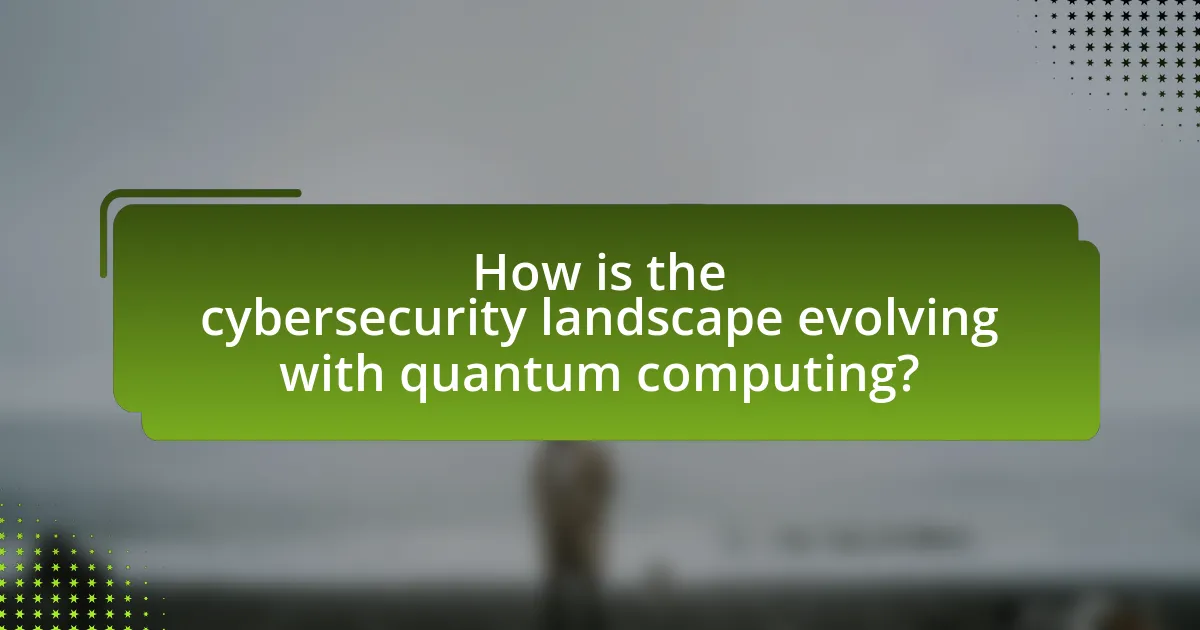
How is the cybersecurity landscape evolving with quantum computing?
Quantum computing is fundamentally altering the cybersecurity landscape by introducing new vulnerabilities and necessitating the development of quantum-resistant encryption methods. As quantum computers advance, they possess the potential to break widely used cryptographic algorithms, such as RSA and ECC, which rely on the difficulty of factoring large numbers and solving discrete logarithms. Research from the National Institute of Standards and Technology (NIST) indicates that quantum computers could render current encryption methods obsolete within the next decade, prompting a shift towards post-quantum cryptography. This evolution requires organizations to adopt new security protocols that can withstand quantum attacks, thereby reshaping the strategies and technologies employed in cybersecurity.
What role do governments and organizations play in quantum cybersecurity initiatives?
Governments and organizations play a crucial role in quantum cybersecurity initiatives by funding research, establishing regulatory frameworks, and fostering collaboration among stakeholders. For instance, the U.S. government has invested over $1.2 billion in quantum research through initiatives like the National Quantum Initiative Act, which aims to advance quantum information science and technology. Additionally, organizations such as the European Union have launched programs like Quantum Flagship, which allocates €1 billion to support quantum technologies, including cybersecurity applications. These efforts are essential for developing standards and protocols that ensure the security of quantum communications, thereby addressing potential vulnerabilities posed by quantum computing advancements.
How are international collaborations shaping quantum cybersecurity policies?
International collaborations are significantly shaping quantum cybersecurity policies by fostering shared standards and frameworks that enhance global security measures. For instance, initiatives like the Quantum Internet Alliance, which includes partners from Europe and the United States, aim to develop interoperable quantum communication systems. These collaborations lead to the establishment of best practices and regulatory guidelines that address the unique challenges posed by quantum computing, such as the potential for quantum attacks on classical encryption methods. Furthermore, joint research projects funded by international bodies, such as the European Union’s Horizon 2020 program, promote the development of quantum-safe cryptographic algorithms, ensuring that nations can collectively prepare for the implications of quantum technologies on cybersecurity.
What funding and research efforts are being directed towards quantum cybersecurity?
Significant funding and research efforts are being directed towards quantum cybersecurity by governments, academic institutions, and private companies. For instance, the U.S. National Institute of Standards and Technology (NIST) has been actively involved in developing post-quantum cryptography standards, allocating resources to research that addresses the vulnerabilities posed by quantum computing to current encryption methods. Additionally, the European Union has invested over €1 billion in quantum technologies, which includes cybersecurity initiatives aimed at enhancing data protection against quantum threats. Furthermore, companies like IBM and Google are conducting extensive research in quantum-safe algorithms, demonstrating a commitment to advancing cybersecurity measures in the face of emerging quantum technologies.
What are the key challenges in implementing quantum computing in cybersecurity?
The key challenges in implementing quantum computing in cybersecurity include the development of quantum-resistant algorithms, the high cost of quantum technology, and the need for specialized knowledge and skills. Quantum-resistant algorithms are essential because current encryption methods, such as RSA and ECC, can be easily broken by quantum computers, necessitating the creation of new cryptographic standards. The high cost of quantum hardware and infrastructure poses a significant barrier to widespread adoption, as organizations must invest heavily in this emerging technology. Additionally, the lack of expertise in quantum computing limits the ability of cybersecurity professionals to effectively integrate quantum solutions into existing systems, hindering progress in this field.
What technical barriers exist in developing quantum cybersecurity solutions?
Developing quantum cybersecurity solutions faces several technical barriers, including the challenges of quantum coherence, error rates, and the complexity of quantum algorithms. Quantum coherence refers to the ability of quantum states to maintain their quantum properties over time, which is crucial for effective quantum communication; however, environmental factors can easily disrupt this coherence, leading to information loss. High error rates in quantum operations also pose significant challenges, as they can compromise the reliability of quantum key distribution methods. Additionally, the complexity of implementing quantum algorithms, which often require sophisticated hardware and software infrastructure, further complicates the development of practical quantum cybersecurity solutions. These barriers hinder the widespread adoption and effectiveness of quantum cybersecurity technologies.
How do cost and resource limitations affect the adoption of quantum technologies?
Cost and resource limitations significantly hinder the adoption of quantum technologies by restricting research funding, limiting access to specialized materials, and reducing the availability of skilled personnel. For instance, the high costs associated with developing and maintaining quantum hardware, such as superconducting qubits or ion traps, can deter investment from both private and public sectors. According to a report from the National Quantum Initiative, the U.S. government allocated approximately $1.2 billion for quantum research in 2021, highlighting the financial challenges faced in scaling these technologies. Additionally, the scarcity of experts in quantum computing exacerbates the situation, as organizations struggle to find qualified individuals to drive innovation and implementation. These factors collectively create a barrier to widespread adoption, slowing down advancements in quantum computing applications, including those in cybersecurity.
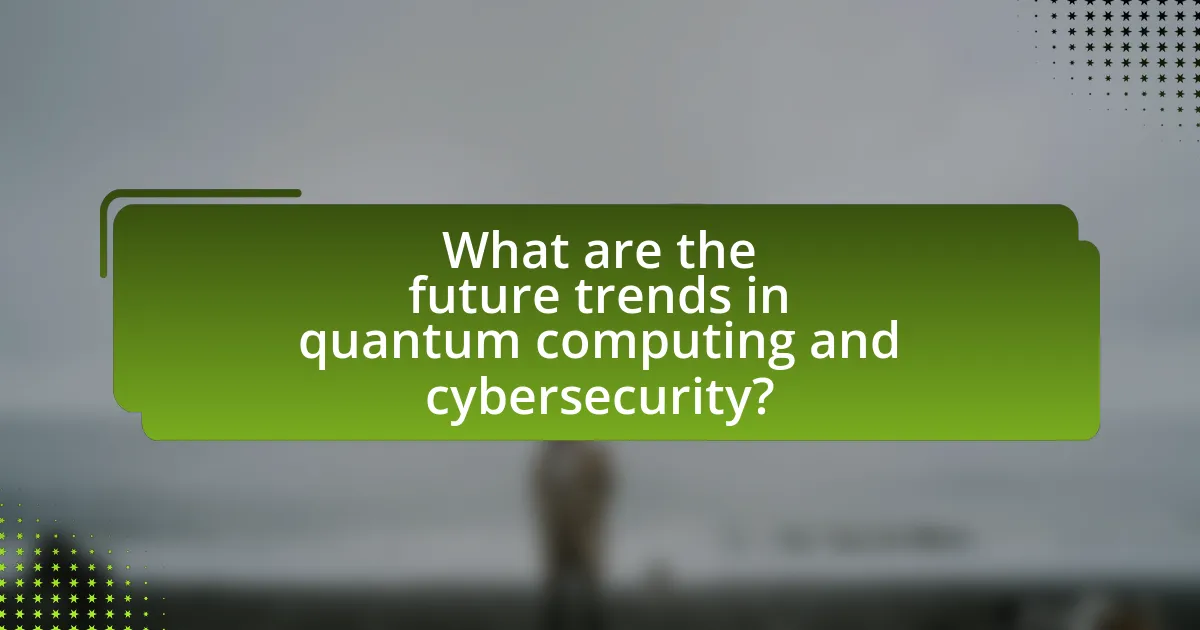
What are the future trends in quantum computing and cybersecurity?
Future trends in quantum computing and cybersecurity include the development of quantum-resistant encryption algorithms and the integration of quantum key distribution (QKD) for secure communications. As quantum computers advance, they pose a significant threat to traditional encryption methods, prompting researchers and organizations to focus on post-quantum cryptography, which aims to create algorithms that can withstand quantum attacks. For instance, the National Institute of Standards and Technology (NIST) is actively working on standardizing post-quantum cryptographic algorithms, with the final selections expected to be announced soon. Additionally, QKD is gaining traction as it utilizes the principles of quantum mechanics to enable secure key exchange, making it nearly impossible for eavesdroppers to intercept the keys without detection. These trends indicate a proactive approach to safeguarding data against the impending capabilities of quantum computing.
How will quantum computing impact the future of cybersecurity jobs and skills?
Quantum computing will significantly transform cybersecurity jobs and skills by necessitating new expertise in quantum-resistant algorithms and cryptographic techniques. As quantum computers become capable of breaking traditional encryption methods, cybersecurity professionals will need to acquire skills in quantum cryptography and develop strategies to protect sensitive data against quantum threats. For instance, the National Institute of Standards and Technology (NIST) is already working on post-quantum cryptography standards, highlighting the urgency for cybersecurity experts to adapt to these advancements. This shift will create demand for specialized training and education in quantum computing, reshaping the skill sets required in the cybersecurity workforce.
What new skill sets will be required for cybersecurity professionals in a quantum world?
Cybersecurity professionals in a quantum world will require advanced skills in quantum cryptography, quantum algorithms, and an understanding of quantum computing principles. As quantum computers can potentially break traditional encryption methods, professionals must be adept at implementing quantum-resistant algorithms and protocols. Knowledge of quantum key distribution (QKD) will be essential, as it offers a method for secure communication that leverages the principles of quantum mechanics. Additionally, familiarity with quantum programming languages, such as Qiskit or Cirq, will be necessary to develop and test quantum applications. The shift towards quantum technologies necessitates continuous education and adaptation to emerging threats and solutions in the cybersecurity landscape.
How can educational institutions adapt their curricula to include quantum cybersecurity?
Educational institutions can adapt their curricula to include quantum cybersecurity by integrating specialized courses that cover quantum mechanics, cryptography, and cybersecurity principles. This approach ensures that students gain a comprehensive understanding of how quantum computing impacts data security. For instance, universities can develop programs that focus on quantum key distribution and post-quantum cryptography, which are essential for securing communications against quantum attacks. Additionally, institutions can collaborate with industry experts to provide hands-on training and real-world applications, enhancing the learning experience. Research indicates that as quantum technologies evolve, the demand for professionals skilled in quantum cybersecurity will increase, making it crucial for educational programs to stay current with these advancements.
What best practices should organizations adopt to prepare for quantum computing in cybersecurity?
Organizations should adopt a proactive approach to quantum computing in cybersecurity by implementing quantum-resistant cryptographic algorithms. This preparation is essential because traditional encryption methods, such as RSA and ECC, are vulnerable to quantum attacks, which can break these systems in polynomial time using algorithms like Shor’s algorithm.
To effectively prepare, organizations should conduct a thorough risk assessment to identify critical assets and data that require protection against quantum threats. Additionally, they should invest in research and development of quantum-safe cryptographic protocols, such as lattice-based, hash-based, or code-based cryptography, which are believed to be resistant to quantum attacks.
Furthermore, organizations should engage in continuous education and training for their cybersecurity teams to stay updated on advancements in quantum computing and its implications for security. Collaborating with industry groups and participating in standardization efforts for quantum-resistant algorithms will also enhance their preparedness.
By adopting these best practices, organizations can mitigate the risks posed by quantum computing and ensure the integrity and confidentiality of their sensitive information.
How can businesses assess their current cybersecurity posture against quantum threats?
Businesses can assess their current cybersecurity posture against quantum threats by conducting a comprehensive risk assessment that evaluates their existing encryption methods and data protection strategies. This assessment should include identifying vulnerabilities in current cryptographic systems, as quantum computers can potentially break widely used algorithms like RSA and ECC. According to the National Institute of Standards and Technology (NIST), organizations should transition to quantum-resistant algorithms to mitigate these risks. Additionally, businesses can engage in threat modeling to understand how quantum computing could impact their specific operations and data security, ensuring they are prepared for future advancements in quantum technology.
What proactive measures can organizations take to enhance their quantum readiness?
Organizations can enhance their quantum readiness by investing in quantum education and training programs for their workforce. This proactive measure ensures that employees understand quantum computing principles and their implications for cybersecurity. According to a report by the World Economic Forum, organizations that prioritize workforce education in emerging technologies are better positioned to adapt to technological advancements, including quantum computing. Additionally, organizations should collaborate with academic institutions and industry leaders to stay updated on quantum research and developments, fostering innovation and strategic partnerships. This collaboration can lead to the development of quantum-resistant algorithms, which are essential for securing data against potential quantum threats.
